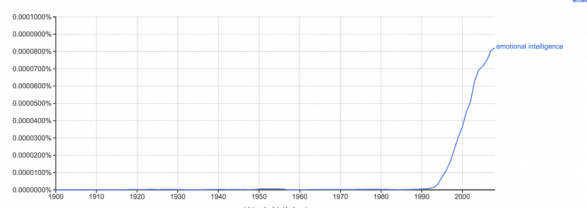- in Blog , Research , Work psychology by David Wilkinson
- |
- 1 comments
Just how valid is the idea of emotional intelligence?

As mentioned in a previous blogs, interest in emotional intelligence is a relatively recent phenomenon. With the exception of a small blip of interest at the end of the Second World War, emotional intelligence has only really come to prominence in terms of research since the 1990s.

Emotional intelligence, however, isn’t one construct, rather it is an overarching description of:
- 4 trait factors within a series of
- 17 variables or measures that,
together, have become known as emotional intelligence.
- The four trait factors of emotional intelligence – states versus traits
- The 17 variables that make up emotional intelligence
- The five implicit measures of emotional intelligence (EI):
- The 12 explicit measures of emotional intelligence
- The study
- Conclusions
- Reference
For free research briefings, infographics and more
The four trait factors of emotional intelligence – states versus traits
Emotional intelligence is made up of four trait factors, called such because they describe habitual and relatively stable patterns of thinking, behaviour and emotional reactions. A trait, for example, is something that would be ascribed to an individual, such as being an outgoing person, for example. In comparison, states are seen as more transitory and situation specific, such things as anger.
The four trait factors of emotional intelligence:
- Self emotional recognition. This refers to the ability of the individual to accurately identify and recognise their own emotional states as they are happening.
- Self emotion regulation. This refers to the ability of the individual to change their own emotional state at will.
- Others’ emotion recognition. This refers to an individual’s ability to accurately identify and recognise the emotional states of others, often from behavioural cues, such as body language or facial expressions.
- Others emotion regulation. This refers to the ability of an individual to have a predefined impact on another’s emotional state. For example, the ability to work out what actions or behaviours may make another individual angry, sad or happy, for example, and then to carry out that action.

The 17 variables that make up emotional intelligence
There are 17 variables, or measures, that together make up the construct of emotional intelligence. These are split into implicit or explicit measures.
Implicit measures are designed to detect the strength of a person’s automatic association between mental representations of objects (concepts) in memory and an emotional state.
Explicit measures are really measures of attitude that are seen as being manifested in an individual’s behaviour. In other words, an explicit measure is a description of how an individual’s attitude can be spotted externally through their actions and behaviour. In essence, explicit measures are behavioural.
The five implicit measures of emotional intelligence (EI):
- Awareness – this refers to an individual’s ability to be conscious and sensitive to general situations around them and comprises being:
- Perceptive
- Observant
- Sensing
- a. Mindful.
- Helpfulness – this refers to the extent to which an individual has a sense of wanting to support others and is:
- Caring
- Supportive
- Attentive
- Understanding.
- Self-awareness – this refers to the level of individuals’ self-knowledge, which is predicted by the level of:
- Introspection
- Reflection
- Intuition
- Insightfulness
- Self-control – also known as composure, self-control comes from a combination of being:
- Together
- Composed
- Stable
- Calm.
- Global EI –an overall measure of an individual’s level of intelligence, individualism and emotional maturity. In particular, it measures factors such as:
- The ability to manage relationships.
- Level of empathy an individual is able to have, especially under stress conditions.
- Poise, or level of presence of mind, self-assurance and composure.
- Adaptability, or flexibility in changing situations.

The 12 explicit measures of emotional intelligence
Together with the five implicit measures, there are 12 explicit measures that combine to create the concept of emotional intelligence:
- Level of self-consciousness.
- Level of vulnerability an individual allows themselves to be aware of.
- General level of gregarious behaviour.
- Ability to be assertive and the level of assertive behaviours they display.
- Level and amount of positive emotions they display generally and in specific situations.
- Feelings – this refers to both the feelings they get in a range of situations and those that they display.
- Level of altruism displayed.
- How tender minded they are from situation to situation.
- Level of sociability they display.
- Amount of self-control they display, particularly in difficult situations.
- Emotionality – this refers to the observable behavioural and physiological signs of an individual’s emotional responses to things. For example, colouring up, showing or displaying internal emotions.
- General well-being, particularly mental well-being and stability.
The study by a researcher at Missouri State University in the United States published in May 2018 looked at how valid and reliable the factors are that make up the construct of emotional intelligence. There has been a lot of uncertainty about the construct and, as a result, there are a wide range of differing measures and indicators. Trying to work out which measure is valid and reliable is difficult as, until now, there has been no overarching validatory study of the concept.
This study did a multiple regression and factor analysis across all of the emotional intelligence factors to see which factors are both reliable and valid.
Overall, the study found that the construct of emotional intelligence is a solid one. The research was able to provide considerable and tangible evidence of both convergent and discriminant validity for the 17-factor model of emotional intelligence. However, the study also found that the implicit and explicit measures tend not to agree with each other. What this means is that instruments that use either explicit or implicit measures may not be measuring the same thing. This means that any instrument that only uses implicit or explicit measurements may not be entirely valid.
Brooks, R. R. (2018). The Development and Validation of Implicit Measures of Emotional Intelligence. Missouri State University Institutional repository 2018
Members go to the membership website > Library and search for “EQ” for the full research briefing, similar research briefings and research infographics and reviews
Not a member?
Apply to join now and get:
- Weekly research briefings sent direct to you every week
- A copy of the Oxford Review containing between twelve and sixteen additional research briefings every month
- Research Infographics
- Video research briefings.
- Special reports / short literature reviews on topics that appear to be getting a lot of research attention or if there has been a recent shift in the thinking or theory
- The ability to request a watch list for new research in keyword areas (as long as it is within the realms of:
- Leadership
- Management
- Human resources (not legal aspects)
- Organisational development
- Organisational change
- Organisational learning
- Learning and development,
- Coaching
- Work Psychology
- Decision making
- Request specific research / brief literature reviews
- Access to the entire archive of previous research briefings, copies of the Oxford Review, infographics, video research briefings and special reports.
- Access to Live Reports – continually updated as new research on the topic is released
- Members only podcasts – research briefings in audio – coming soon
- Live continually updated reports
Be the most up-to-date person in the room
Apply to join now
Be impressively well informed

Get the very latest research intelligence briefings, video research briefings, infographics and more sent direct to you as they are published
Be the most impressively well-informed and up-to-date person around...

1diamond